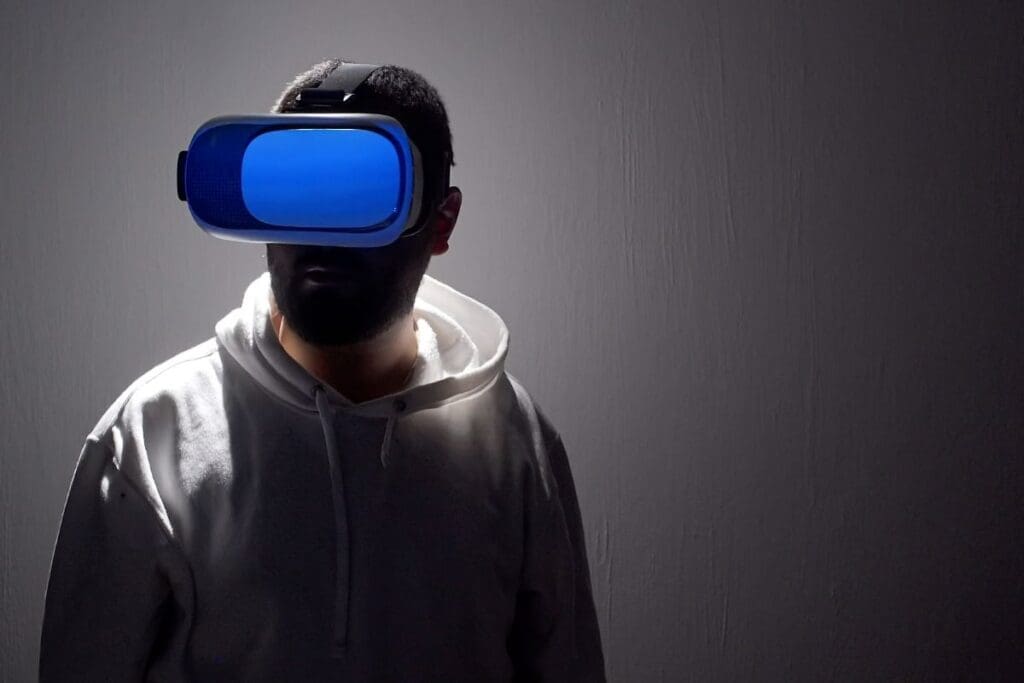The Essential Infrastructure for Metaverse

Dr. Thomas King, the CTO of DE-CIX, delved into the intricacies infrastructure providers will face and outlined essential steps to lay the groundwork for the internet’s future.
What does the future hold for the internet? Inspired by science fiction from Star Trek’s Holodeck to the Matrix, the collective vision of popular culture hints at digital twins “programmed” to reflect our real-life selves. This vision includes an immersive internet filled with digitally created 3D spaces where individuals can interact in an environment that blurs the lines between reality and virtuality. Although this vision is not yet fully realized, strides are being made towards crafting the internet of the future.
To foster a truly immersive and interactive internet experience, it’s crucial to develop and widely adopt end-user technology specifically designed for this purpose. Additionally, constructing a digital infrastructure capable of handling vast data volumes with minimal latency is essential. Over the coming decades, to turn science fiction into reality, we will need access to sophisticated devices, including advanced video and audio equipment.
The envisioned responsive internet experience will revolve around interactions between our digital twins and those of others, real-world objects, and entirely virtual objects and environments. This experience will be powered by virtual reality, extending beyond just headsets.
The future internet will require wearable devices that can convey sensations like pressure, temperature, texture, aroma, and other sensory data. These data streams, synchronized with audio and video streams depicting three-dimensional spaces, must be flawlessly integrated. Any delay in these data streams could disrupt the experience, reducing the realism and enjoyment of the interaction.
Programming the real world

The creation of high-definition, 3D virtual representations of real-world spaces will depend on numerous video streams, offering a comprehensive 360-degree virtual perspective. Wearable sensors and brain-computer interfaces (BCIs), whether implemented as embedded chips or surface sensors in headphones, will monitor our intentions and actions, translating them into movements within the virtual realm.
This data will direct the video stream delivered to each user. Tactile feedback, such as the sensation of holding or moving objects, like shaking hands with a partner or remotely operating a vehicle, will need to be flawlessly incorporated into the user or device-specific data.
These data streams must be synchronized to the millisecond using artificial intelligence to avoid the disorienting sensation of the virtual world lagging and attempting to catch up as you turn your head. Remember, these data streams have to be transmitted live, demanding substantial bandwidth and minimal latency. Current cloud gaming and virtual reality applications give a glimpse into the required capacity. Today, a maximum delay of 20 milliseconds is deemed tolerable for an optimal gaming experience.
As the level of interaction within a scenario increases, the required latency decreases. For 360-degree 8K cloud VR, latency must be less than 10 ms. From a bandwidth standpoint, cloud gaming necessitates a steady 35-50 Mbps throughput. For a robust virtual reality experience, such as interactive shopping in 8K resolution at 90 frames per second, up to 1 Gigabit per second bandwidth is necessary for a single user. If others are also online, the needed connection speed will significantly increase in the near future.
Cyber-physical continuity, which signifies the fluid transition and interplay between the physical and digital realms, is currently being refined. The introduction of this concept began with the Nintendo Wii game console, marking an initial step in merging the physical with the virtual. Existing VR and AR technologies lay the groundwork for this experience, and each new generation expands the possibilities. Exoskeletons enveloping the user’s body allow for remote manipulation in challenging environments.
Non-fungible tokens (NFTs) provide a way to authenticate ownership of digital assets, safeguarding our digital identity and protecting our digital twin from unauthorized use. It remains to be seen whether we will designate a specific room in our homes or offices as a gateway to our digital existence, or carry an enhanced form of augmented reality (XR) with us. Both scenarios are likely to exist concurrently, depending on the stage of technological advancement or specific use cases.
In summary, we’ll be able to shake hands and mingle with others in cyberspace, reach new heights in gaming, and embrace our children goodnight digitally. What further possibilities lie ahead remains to be seen. However, it’s important to note that even current technologies are pushing the limits of today’s hardware and internet infrastructure, and managing upcoming innovations will pose even greater challenges.
Difficulty of distances – being as close to the user as possible

On the luxury consumer tech scene, it’s common for substantial investments to focus on cutting-edge developments. Yet, the success of the cyber future we envision largely depends on what happens behind the scenes: a digital infrastructure capable of smartly storing, analyzing, processing, exchanging, multiplexing, synchronizing, and delivering data streams to end-user devices within milliseconds. This rapid processing is crucial for innovations in responsive virtual reality, which demand exceedingly low latency.
For certain applications, achieving latencies as low as 1 millisecond, or even half a millisecond, is necessary. Due to the limitations imposed by the speed of light, interactions with latencies around one millisecond will be feasible only for users and objects within close proximity (up to about 80km, considering the most direct routing and lowest latency interconnections, along with processing and round-trip times, assuming 5G and fiber optics). Therefore, such low-latency applications will be restricted to local activities like remote robot control for cleanup or rescue operations in dangerous settings, or conducting highly specialized surgeries from a central hospital within the local region. Interpersonal interactions, entertainment, gaming, and online shopping can withstand latencies ranging from 5 to 15 milliseconds, allowing for distances of approximately 400 – 1,200 km from the data center.
The question then is, how achievable is this scenario? On a 5G-enabled campus, achieving high bandwidth and low latencies up to 1 millisecond is already a reality. However, a standalone 5G network cannot match the extensive digital infrastructure that links enterprise and end-user networks to cloud services, data centers, the internet backbone, and beyond. As other infrastructure elements evolve to meet the capabilities of next-gen wireless networks, the responsive internet is set to revolutionize not just 5G and future 5G networks but also Wi-Fi 6 and 7.
To accomplish this, digital infrastructure must be significantly closer to the user, signifying a new era of edge computing (think container data centers in every neighborhood and computing units in basements). Whether through 5G or fiber to the home/building (FTTH/B), achieving high-bandwidth last-mile connectivity and dense access to interconnected infrastructure is essential. This represents the ultimate frontier of speed.
The internet of the future will require tech neutrality

Achieving the envisioned level of digital infrastructure for an immersive internet experience is a significant undertaking. It will require a densely interconnected infrastructure network that leverages both current and emerging networking technologies. This means a substantial increase in the number of data centers, as well as extensive fiber and 5G networks that serve users everywhere—not only in major cities but also in smaller towns across the globe. Each will need scalable interconnect infrastructures to support low-latency, high-bandwidth environments.
Moreover, maintaining the internet’s openness and neutrality while ensuring user flexibility is paramount. The challenges of interoperability and portability in systems, as highlighted by companies’ concerns over dependency on specific cloud service providers, underscore the importance of an open internet.
This openness has been fundamental to the internet’s rapid evolution, fostering interoperability and standardization. Thus, achieving various levels of standardization to ensure interoperability, alongside a diverse and technologically neutral infrastructure, is critical to preserving this openness.
The potential of an immersive responsive internet hinges on the ability of systems and perceptions to interoperate, and for assets to move fluidly across different domains within the foundational infrastructure of the internet of digital twins. The future will not be dominated by a single “metaverse” or cloud but will feature multiple universes.
These universes must adhere to common protocols and share an understanding of data management to enable interactivity. To turn this vision into reality, the infrastructural network linking these universes must be as seamless as the connections within them, ensuring smooth transitions and interactions across the digital landscape.
The connection mesh to carry the tactile internet

In the initial phases of the future internet, a collaborative effort among all network technologies, including potentially 3G mobile and copper cables in certain areas, will be essential to attain the necessary coverage density.
However, as we progress, upgrading outdated technologies to newer versions that offer significantly higher bandwidth and reduced latency will become indispensable to accommodate more sophisticated applications. Internet service providers will be expected to implement network caching for content and media to swiftly serve end-users, similar to the approach taken by current streaming services. The demand for data centers situated much closer to users will grow to accommodate AI applications and digital twins, as well as to cache expansive virtual environments.
To satisfy the bandwidth requirements of emerging immersive applications, high-performance interconnect platforms that maintain local traffic and support 800GE and Terabit Ethernet (TE) connections, beyond the current 400 Gigabit Ethernet (GE) connections every 50-80 km, will become necessary.
Future Internet Exchange Points, designed to facilitate data exchange with minimal latency, will operate fully automatically, be secured with state-of-the-art encryption technologies, and offer high flexibility. These interconnection platforms will have to be data center and carrier neutral to unite a critical mass of digital infrastructure stakeholders, fostering collaboration across different evolving digital universes and bringing networks and data centers closer together.
Through such collaboration, we can create the interwoven infrastructure of the future, enabling intelligent interconnection of devices, data streams, clouds, and data centers with low latency and high bandwidth. Yet, if we consider 5-15 milliseconds as the standard latency for general-purpose applications of the immersive internet, distance will impose limitations on interactions.
The optimal round-trip time (RTT) for data traveling halfway across the globe exceeds 130 milliseconds, not accounting for processing time, and that’s without considering latency in communications with humans on the Moon or Mars. In the decades ahead, we will face significant delays in intercontinental or interplanetary communications, necessitating different approaches for various applications. But perhaps by that time, we will have developed new solutions to overcome these challenges.
You may also like this content
Follow us on TWITTER (X) and be instantly informed about the latest developments…











